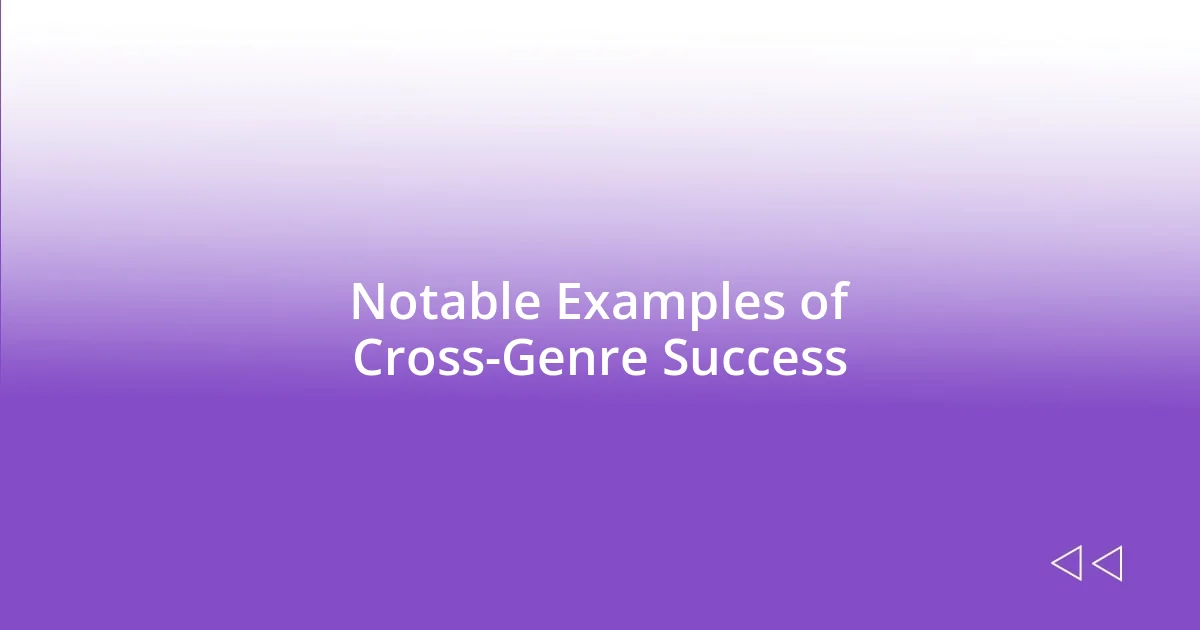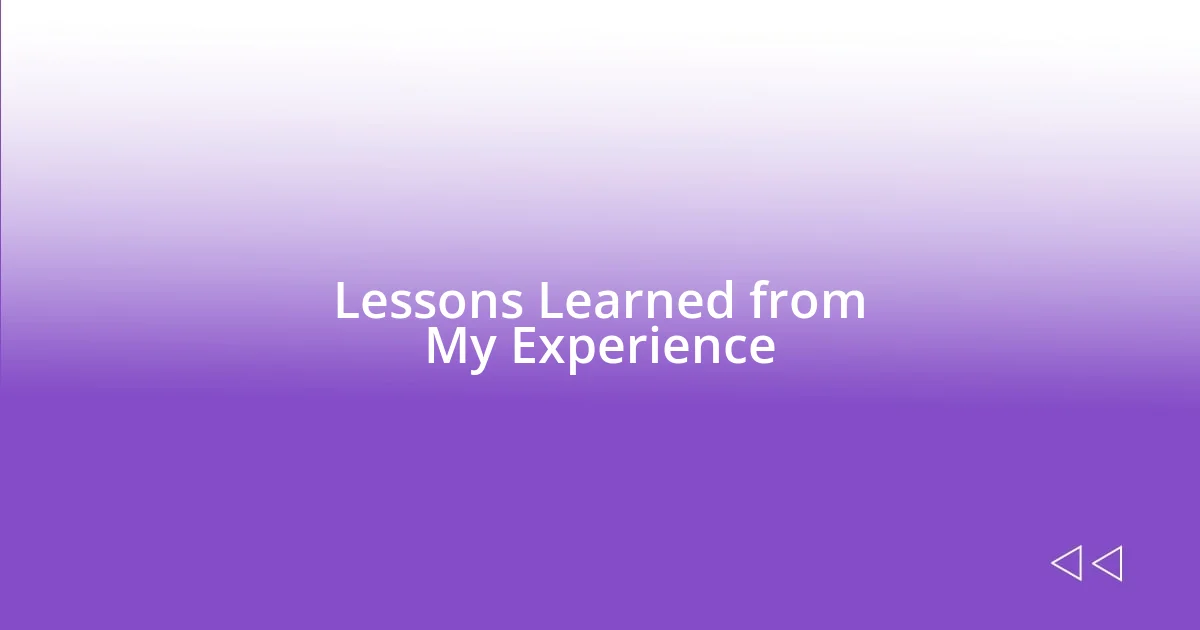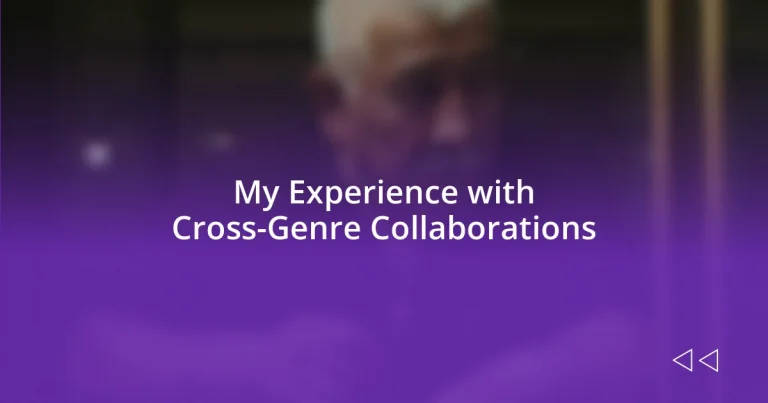Key takeaways:
- Cross-genre collaborations encourage creativity and innovation by merging diverse musical styles, leading to unexpected transformations.
- Key benefits include gaining new perspectives, enhancing emotional depth, and building supportive artistic communities.
- Successful collaborations rely on strong communication, flexibility in adapting styles, and the importance of patience and listening to each other’s visions.

Understanding Cross-Genre Collaborations
Cross-genre collaborations offer a unique playground for creativity, where artists from different musical backgrounds unite and fuse their styles. I remember my first experience with such a collaboration, stepping into a studio with a jazz musician while my roots were firmly in rock. The energy was electric, and I found myself wondering, how could these two genres blend seamlessly?
It often feels like crossing a bridge into uncharted territory, yet the beauty lies in the unexpected discoveries along the way. I’ve learned that marrying different musical elements can spark innovation. The rush of blending a melodic rap verse with a classical piano piece filled me with a sense of freedom I hadn’t felt before. Imagine the possibilities when genres collide!
Ultimately, it’s about finding common ground and respecting each other’s artistic visions. I’ve found that these collaborations require vulnerability, allowing each collaborator to share their influences while trying to create something new together. Isn’t it fascinating how such partnerships can push boundaries, challenge perceptions, and create music that resonates on multiple levels?

Enhancing Creativity Through Collaboration
Collaborating across genres has a remarkable way of expanding creative horizons. I recall a session where I teamed up with a hip-hop artist. Initially, it felt intimidating—how would my melodic influences mesh with their rhythmic flair? But once we started exchanging ideas, I felt a rush of inspiration as we mixed my acoustic guitar riffs with their beats, creating something vibrant and fresh. It’s as if a creative floodgate opened, showing me how intertwined our artistic energies could be.
Engagement between different styles often leads to unexpected transformations in our musical processes. I once joined forces with a classical violinist for a project. The intricate melodies she played wove seamlessly into the pop backbone I had in mind, creating a tapestry of sound that neither of us could have achieved alone. This experience taught me the value of embracing another artist’s perspective and believing in the beauty of collective creation. The emotional connection made the final product not just a song but a shared expression of who we both are.
When artists come together, they often immerse themselves in new techniques and ideas, significantly enhancing their creativity. I’ve noticed that cross-genre collaborations push me to stray from my usual formulas, urging me to explore sounds I might have otherwise overlooked. And isn’t that the essence of artistic growth? Each partnership opens a door to a realm of inspiration and creativity that can redefine our understanding of music.
| Collaboration Type | Creative Impact |
|---|---|
| Jazz/Rock | Fused styles led to a fresh sound and unexpected musical directions. |
| Hip-Hop/Pop | Bridged lyrical depth with catchy hooks, creating an energetic anthem. |
| Classical/Pop | Combined intricate melodies with modern rhythms, enhancing emotional resonance. |

Key Benefits of Cross-Genre Work
Experiencing cross-genre collaborations has enriched my understanding of musical expression in ways I never anticipated. I still vividly recall a moment in the studio, blending country melodies with electronic beats. That initial uncertainty quickly transformed into delight as we crafted a track that felt both nostalgic and avant-garde. It reminded me that stepping outside my comfort zone could yield extraordinary results.
Here are some key benefits I’ve discovered through cross-genre work:
- Diverse Perspectives: Collaborating with artists from different backgrounds opens my mind to new viewpoints, often leading to unexpected creative breakthroughs.
- Innovation: Fusing different styles challenges traditional norms, enabling unique sounds that set my work apart in the crowded music scene.
- Emotional Depth: The combination of influences often enhances the emotional impact of a piece, allowing listeners to connect with the music on multiple levels.
- Skill Development: Interacting with artists skilled in other genres pushes me to learn new techniques, broadening my musical repertoire.
- Community Building: These partnerships forge new relationships, creating a network of support and collaboration that enriches everyone’s artistic journey.
Each collaboration leaves a mark, refining my artistry and reminding me of the magic that occurs when we embrace the unknown. I find it exhilarating to watch these innovations unfold, like canvas splashes of color creating a masterpiece no one could have imagined alone.

Tools for Effective Genre Blending
When it comes to effective genre blending, having the right tools in your creative toolkit can make a world of difference. For instance, I often rely on digital audio workstations (DAWs) to layer diverse sounds seamlessly. There’s something liberating about manipulating beats and harmonies in real-time, allowing me to experiment without limitations. Doesn’t it feel like each software upgrade opens new avenues for innovation?
A crucial tool I’ve embraced is the use of collaborative platforms like Splice or Soundtrap, which encourage real-time sharing of ideas and tracks. During a recent project with a jazz musician, these platforms became our playground. We could throw ideas back and forth, tweaking things instantly as we explored the fusion of smooth jazz lines with upbeat pop rhythms. It was pure magic! Can you imagine the energy that flows when collaboration happens instantly?
Additionally, I find that keeping an open mindset is just as important as any physical tool. It’s about letting go of rigid genre boundaries and embracing the unexpected. I once participated in a jam session where we mixed reggae grooves with orchestral strings. As those genres intertwined, I felt a sense of joy that came from breaking creative molds. Have you ever noticed how the most beautiful creations often arise from sweet spontaneity?

Tips for Successful Collaborations
To create successful collaborations, communication is key. I’ve found that sharing my thoughts and expectations early on can set the tone for an open dialogue. During a past project, a simple chat about our artistic visions prevented misunderstandings and paved the way for a smoother creative process. Have you ever noticed how the best collaborations thrive on clarity?
Flexibility is another essential element. I remember working with a hip-hop artist who had a very different approach to rhythm than I was used to. Instead of sticking to my original plan, I adapted my style to incorporate his flow. This willingness to bend my own norms allowed us to create something genuinely special together. Isn’t it fascinating how stepping back can actually propel your creative output?
Lastly, I cannot stress enough the importance of patience. There were times when I felt frustrated during collaborations, particularly when ideas didn’t come together immediately. However, giving each other the space to breathe often led to moments of inspiration that transformed the project. In your experience, have you discovered that taking a step back sometimes brings clarity to chaotic creativity?

Notable Examples of Cross-Genre Success
One striking example of successful cross-genre collaboration in my experience is the collaboration between the folk artist Sufjan Stevens and indie rock band The National. Their project “Best of Both Worlds” beautifully merged Stevens’ delicate melodies with The National’s atmospheric soundscapes. I remember listening to their fusion and feeling an emotional tug as the layered instrumentation complemented the poignant storytelling typical of both artists. Have you ever stumbled upon a track that just resonates on so many levels?
Another notable case is the collaboration between DJ Khaled and artists from varying backgrounds in tracks like “I’m the One.” This song seamlessly combines elements of hip-hop, R&B, and pop, showcasing how versatility can create chart-topping hits. Listening to it, I can’t help but appreciate how the different vocal styles enhance the overall richness of the track. It’s fascinating, isn’t it, how artists from diverse genres can come together to create something that’s not only enjoyable but also pushes the boundaries of their respective styles?
I also reflect on my own experience working with a classical pianist and a hip-hop producer. It was exhilarating to see how the intricate piano lines could support the heavy beats, creating a sound that was both fresh and innovative. There was a moment when the piano solo met the rap verses in a way that sent chills down my spine. It’s moments like these that remind me of the magic that can happen when genres collide. Have you ever experienced that spine-tingling thrill when unique sounds blend together?

Lessons Learned from My Experience
One major lesson I’ve learned is the art of listening. I remember a collaboration where my partner had this incredible vision I initially couldn’t grasp. By taking the time to really understand their perspective, I realized we were on the same wavelength, just approaching it from different angles. Have you ever considered how listening can unlock hidden potential in a project?
Additionally, I’ve come to value experimentation. There was a time I was hesitant to try unconventional sounds, but collaborating with a jazz saxophonist pushed me out of my comfort zone. Our late-night jam sessions turned into eye-opening experiences where we discovered unexpected musical textures. Isn’t it exciting to think that some of the best ideas can emerge from stepping into the unknown?
Finally, I’ve learned that celebrating small victories can make a massive difference. During a collaborative project, we would pause to appreciate each new idea, no matter how minor it seemed. Those moments of acknowledgment fueled our motivation and creativity, transforming our process into an energetic celebration rather than just work. Don’t you find that recognizing progress can shift the entire dynamic of a project?














